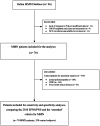Nerve Conduction Abnormalities Beyond Conduction Block in Multifocal Motor Neuropathy. Impact on Diagnostic Criteria Accuracy
- PMID: 40984777
- PMCID: PMC12454919
- DOI: 10.1111/ene.70300
Nerve Conduction Abnormalities Beyond Conduction Block in Multifocal Motor Neuropathy. Impact on Diagnostic Criteria Accuracy
Abstract
Background: Multifocal motor neuropathy (MMN) is a rare motor neuropathy diagnosed by identifying motor conduction block (CB), which may be absent or transient. This study aimed to evaluate nerve conduction abnormalities beyond CB and their diagnostic value.
Methods: A retrospective analysis included patients fulfilling the 2010 EFNS/PNS clinical criteria for MMN and controls with axonal polyneuropathy, lower motor neuron disease, or chronic inflammatory demyelinating polyradiculoneuropathy (CIDP). Electrophysiological studies evaluated motor distal latency prolongation, reduced motor conduction velocity, prolonged F-wave latency, absence of F-waves, abnormal temporal dispersion, and distal CMAP duration prolongation. The 2010 EFNS/PNS criteria for MMN were compared to an 'extended' set incorporating additional electrophysiological parameters.
Results: A total of 70 MMN patients and 359 controls were included. At least one nerve conduction abnormality, excluding motor CB, was detected in one or more nerve segments unaffected by CB in 71% of MMN patients, significantly more frequently than in axonal polyneuropathy or lower motor neuron disease patients. These parameters included abnormal temporal dispersion (47%), distal CMAP duration prolongation (31%), reduced motor conduction velocity (26%), absence of F-waves (9%), prolonged F-wave latency (6%), and motor distal latency prolongation (3%). Incorporating these parameters increased sensitivity for diagnosing probable/definite MMN by 26% (p < 0.001; compared to EFNS/PNS criteria), with minimal impact on specificity, even when compared to CIDP patients.
Conclusion: Including additional electrophysiological parameters into the diagnostic criteria for MMN may enhance diagnostic sensitivity while maintaining comparable specificity. The observation of nerve conduction abnormalities beyond CB indicates a broader electrophysiological profile for MMN.
Keywords: MMN; conduction block; diagnosis; diagnostic criteria; multifocal motor neuropathy.
© 2025 The Author(s). European Journal of Neurology published by John Wiley & Sons Ltd on behalf of European Academy of Neurology.
Conflict of interest statement
Pietro Emiliano Doneddu reports personal fees for Advisory from ArgenX, and received travel grants to attend scientific meetings from CSL Behring and Kedrion. Giuseppe Cosentino has received travel grants to attend scientific meetings from CSL Behring and Kedrion. Massimiliano Filosto has served on scientific advisory boards for CSL Behring, Sanofi, and Amicus, and has received travel grants from Sanofi, Biogen, Kedrion, and CSL Behring to attend scientific meeting. Anna Mazzeo has received travel grants from Kedrion and CSL Behring to attend scientific meeting. Maurizio Inghilleri has received travel grants to attend scientific meetings from CSL Behring, ArgenX, and Alexion. Federica Moret has received travel grants to attend scientific meetings from CSL Behring, ArgenX, and Alexion. Eduardo Nobile‐Orazio reports personal fees for Advisory or Scientific Board from ArgenX—Belgium, Takeda—Italy and USA, CSL Behring—Italy and USA, Janssen—USA, Kedrion—Italy, LFB—France, Roche—Switzerland, Sanofi—USA. The other authors declare no conflicts of interest.
Figures


References
MeSH terms
Grants and funding
LinkOut - more resources
Full Text Sources

